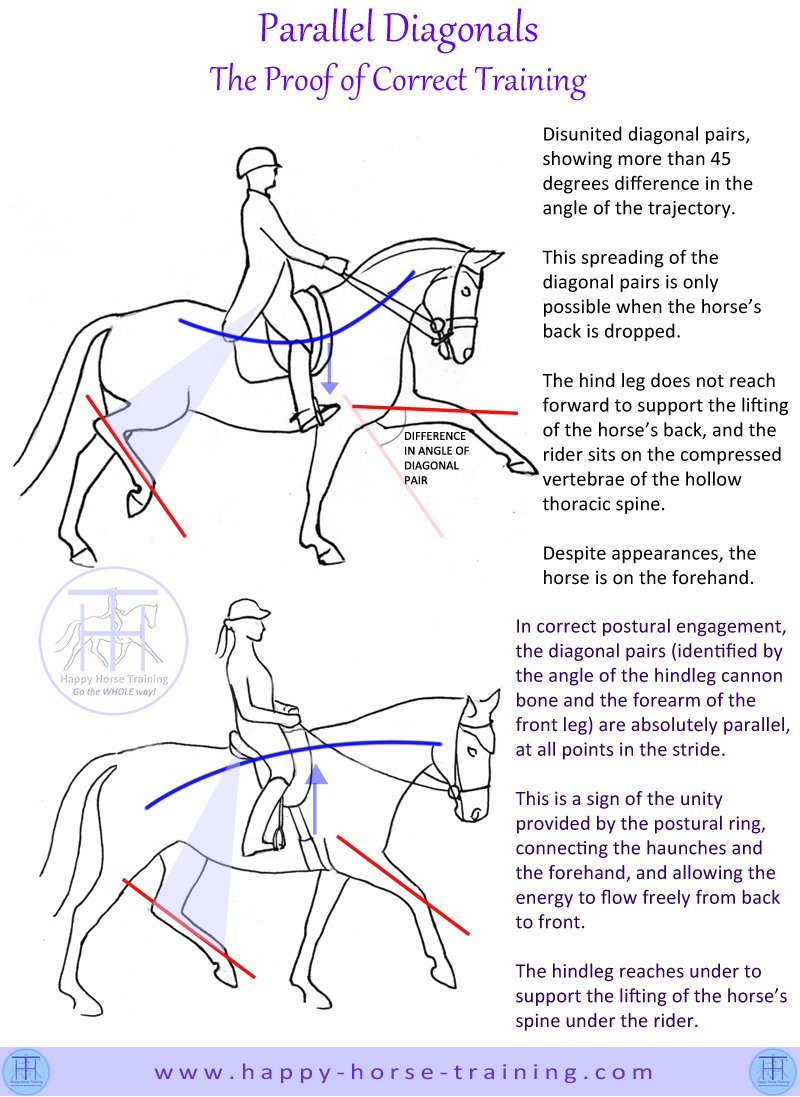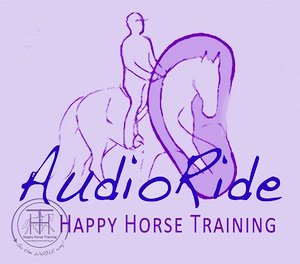Parallel Diagonals
The Proof of Correct Training
The spectacular high foreleg action, which has become desirable in modern dressage, tricks the eye of the observer into thinking the horse is up off the forehand, carrying the rider strongly and proudly.

Dispite the impressive appearance of the top image (taken from a photo of an Olympic medal winning rider), the horse's hindlegs are forced out behind by the blocking rein contact. They are unable to reach forward and support the lifting of the thoracic
spine, where the rider sits. The horse’s spine is hollow, dropping the rider’s weight onto the horse’s already burdened forehand.
The spectacle is nothing more than a surface appearance, which serves
neither horse nor rider towards the goal of gymnastic purity in dressage
training.
The bottom diagram is taken from a photo of one of our horses, working in postural engagement. This horse's natural conformation and athleticism cannot be compared to the first horse, however the work is of real gymnastic value because it is balanced posturally, not with the reins. The parallel diagonals prove this.
The unity of the diagonal pairs in trot is a
fundamental characteristic of the horse's natural movement, and is
therefore a key marker of the purity of the gaits, which correct
dressage sets out to preserve above all.
When the horse is balancing
by means of the engagement of the postural ring, the diagonal pairs
swing together in unison, right through the carrying phase of each pair
every stride.
In a reciprocal relationship, the stability of the
postural ring supports the hindleg reaching forward under the body of
the horse, and, in turn, the hindleg stepping under in this way supports
the postural ring, feeding the whole biomechanical dynamic with
channelled energy. The rider feels this energy lifting the horse's back
under the seat, and this also supports the rider's postural engagement
and balance.
Only when the rider blocks the flow of energy
through the horse's spine with holding hands, and artificially raises
the head-carriage, can the unity of the diagonals be corrupted to a
significant degree, because the hindleg is blocked from stepping
through, and the forelegs are unnaturally levered upwards.
If
we want a truly infallible sign of correct dressage, we should look
first to the diagonals, instead of obsessing over the head-carriage,
which is a totally unreliable sign of good work as it can be affected by many factors including individual horse conformation.
The endemic nature
of incorrect diagonals in competitive dressage, in all trot-based
movements, is a telling sign of the degree to which correct riding and
training has been abandoned.
To see this for yourself, you only have to pause a video (taken from the side) of a horse being ridden in trot or trot-based movements (including piaffe and passage) when the foreleg is at the highest point of the carrying phase of the stride. It is extremely rare to find the hindleg canon bone at the same angle as the forearm of the foreleg.
For further explanation of postural engagement - the true foundation of correct dressage - see this article: What does 'on the bit' really mean?
Go back to the HHT Dressage Diagrams index page
Return from Parallel Diagonals to the Happy Horse Training home
The pages on HHT are so wide-ranging and interrelated that we strongly recommend you look at the site plan to find other subjects that may interest you.
New from HHT!
AudioRide is a series of exercises designed to listen to while you ride.
Audio descriptions guide you through each step of developing a balanced, dynamic connection with the horse through your position.
This truly innovative learning tool gives you a whole new way of being guided in your riding, in a calm, clear, step-by-step way.
Free Download! Introductory Exercise: Riding in the Now
The Gymnastic Rider eBook
Now available exclusively from HHT!
A unique, comprehensive guide to practical rider biomechanics. This professionally produced eBook takes the rider through the process of developing their body in the specific way that brings the horse's movement into harmony and balance, without force and constraint. Click here for full details, and to download the 15-page introduction to the book for free.
Join the Happy Horse Training group on Facebook!
See and share topical info, news and photo's, and take part in lively discussions.
Click here to go to the HHT group (make sure you log into fb first) and then click on the 'join' button at the top of the page.
Join the Whole Horse Newsletter!
HHT's free monthly newsletter giving you wide-ranging and intelligent insights into holistic horsemanship.
Just enter your details below to join.
Free bonus on the riding position with all new subscriptions: Ten Top Tips To Instantly Improve Your Connection With Your Horse.
Click here to see back issues of The Whole Horse newsletter
Train Your Horse
The Holistic Way
How To Train A Horse Without Force
is a unique guide to training horses through energetic connection and
gymnastic training. Part 1 covers everything on the ground, from
handling to the lungeing technique that develops strength, straightness
and engagement. Comes with a free eBook supplement on Horse Trauma.
Click here for more details.
"As a student of Zen Buddhism for nearly three decades, I've often wondered when someone was going to write the book on Zen and the art of horsemanship, and I think that your emphasis on mindfulness and energy connection gets right at the heart of the matter."
- Prof. Teresa Lloyd, U.S.
Do You Have
A Horse Story
To Share On HHT?
So many people have been through
wonderful experiences with horses, whether in training or otherwise. If
you've made a change in a horse's life - or one has made a change in
yours - tell us about it here.
Learn The Natural Barefoot Trim - The Simple Way
The Simple Seven-Step Natural Trim is a comprehensive step-by-step guide to a cutting-edge barefoot trim. Click here to find out more.
What people say about HHT:
"The riding instruction is outstanding, if instructors in the UK taught this way there would be a lot of happy riders and horses."
"The riding tuition exceeded my hopes and expectations by a long way; giving me an exciting new facet to horsemanship which is lighter. more subtle, more elegant and more meaningful. It is as if a new door has opened bringing more sunlight and air."
"My goodness - what a change has taken place in my riding. I think that I'm starting to sit 'into' the horse rather than on top of him. I felt my horse's movements in a way that has almost never happened before"
Click on Testimonials for more










New! Comments
Anything to say about this page? Leave your comment in the box below.